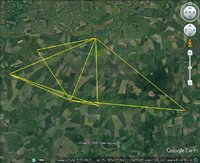Mark Paxton
New member
- Joined
- Oct 18, 2020
- Messages
- 11
I am not a student and have no mathematical knowledge but I am looking for an answer and maybe somebody can help.
The question is "What is the probability of six random points creating five isosceles triangles?"
I realise there must be some tolerance (say 1% or 0.5%) on the side lengths of the triangles, or some dimension to the points.
Thank you to anyone who has the time to consider this.
Mark
The question is "What is the probability of six random points creating five isosceles triangles?"
I realise there must be some tolerance (say 1% or 0.5%) on the side lengths of the triangles, or some dimension to the points.
Thank you to anyone who has the time to consider this.
Mark

